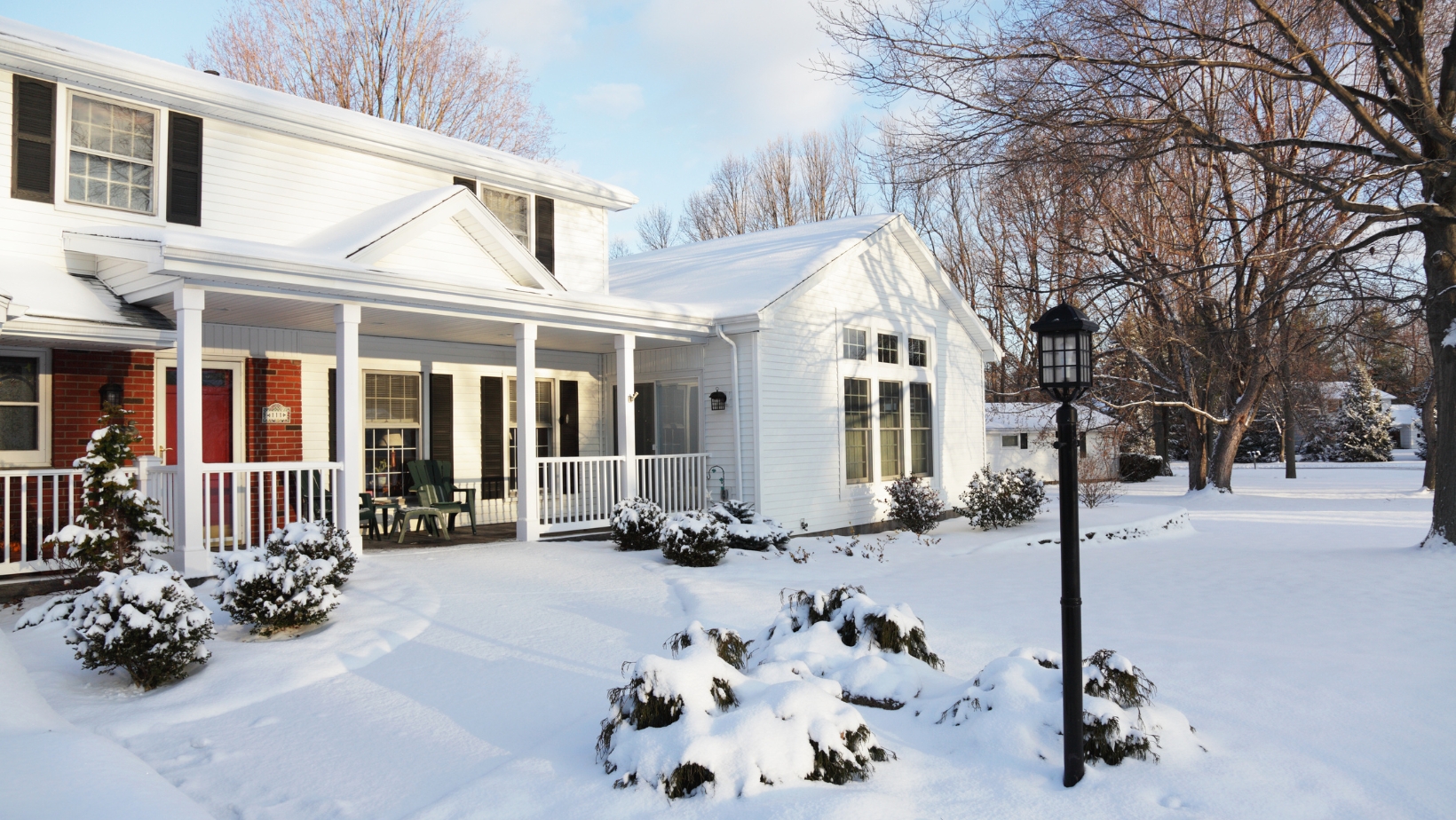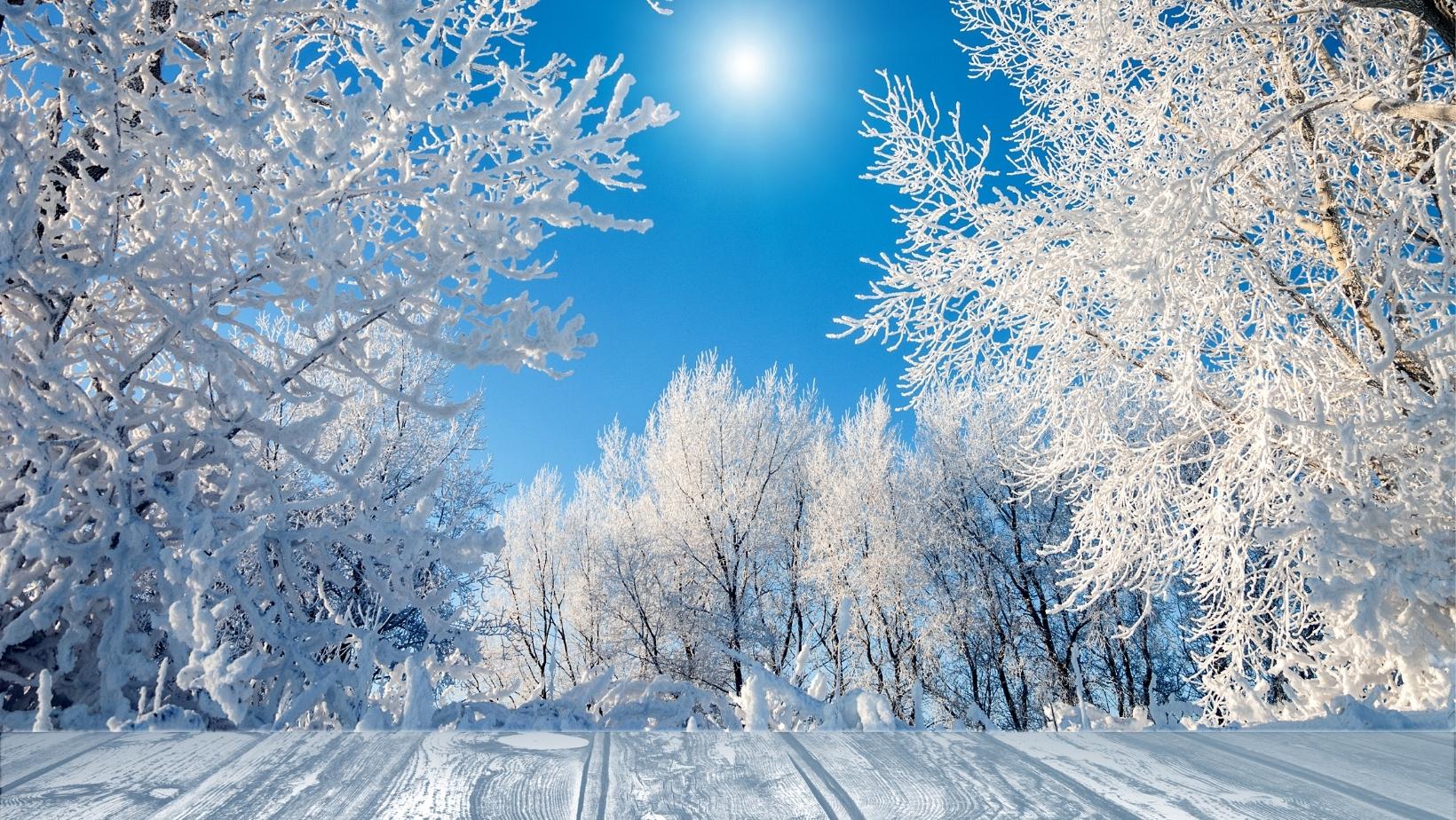10 Tasks for Winter Home Maintenance

The winter months are long and arduous, not only for yourself but for your home. Here are a few maintenance tips to do and keep in mind over the colder months.
Change Your Furnace Filters
Ventilation is crucial in winter, as we spend most of our time indoors. In frigid weather, our furnaces work harder than ever, and a clean filter can help it immensely. The filters are easily replaced but often forgotten about.
While considering furnace air circulation, check your kitchen and bathroom exhaust fans to ensure they work correctly and remove moisture from the air. An easy method to check fans is holding a tissue up to it and seeing if it gets pulled into it. If it seems amiss, clean the fan thoroughly or replace it.
Foggy Frost-Covered Windows Means Weeping Windows
If you notice your windows are accumulating condensation or even frost, there could be various reasons. It could be faulty windows, humidity or poor ventilation. Properly investigate windows with these issues because weeping windows can lead to mould and compromise the window’s structure. Purchasing a hydrometer will allow you to check the humidity throughout your home. If the humidity levels are higher in certain areas, buy a dehumidifier. If the humidity is low, invest in a humidifier. Your home’s humidity should be at 40-60%.
A simple fix to try out first is to caulk around windows and doors—remove old cracked caulking and re-apply. Replace the seals and weather stripping around all windows and doors to stop cold drafts from coming in rather than cranking up the heat.
Chimney Inspections
Chimneys should need to be inspected annually, especially if there is a fireplace at the bottom. If you have furnace ventilation out the chimney, it should be through a metal pipe, and fewer issues can arise.
Inspect the chimney for creosote or soot. Both can be serious fire hazards—chimney fires can spread rapidly through your home. Also, make sure there is no damage to the chimney. A block or crack can lead to toxic fumes, such as carbon monoxide, entering your home. Even with a gas fireplace, it is essential to ensure air flow is coming in and out.
Check Your Smoke Alarms and CO Detectors
Speaking of fire hazards, check your smoke detectors often to ensure they are in proper working order. Replace the batteries or unit if needed. Check the CO detectors also. Write a reminder on the first of the month to check all units, as it’s better to be safe than sorry.
Plug In Safely
This holiday and winter, check all extension cords and power bars to ensure they are in good condition. If they are in bad shape, with exposed cords or tears, don’t tape them. Throw them away. Be wary of overloading your circuits.
Watch Out For Icicles
Icicles and ice dams should not be ignored. They usually form on the edges of your home where it’s slower to melt, preventing the water from draining off your roof. The backup meltwater can find its way into your home walls and basement. If you see an ice dam forming and cannot remove it yourself, look into hiring a professional to assist you. They can look at the eaves and inside your attic, because you need proper airflow and insulation to prevent ice from forming.
Winterize Your Pipes
Canada has extremely cold winter days. These days can wreak havoc on your pipes. When water freezes, it expands, putting pressure on pipes below insulation or through cold zones. The freezing water in the pipes can cause them to burst and flood your home. If your pipes are outside or close to the outside wall, you can wrap them with insulation. Ensure the exterior hose pipes were drained in Autumn. Invest in non-freeze hose bibs that help prevent pipes from bursting. If you plan to travel this winter, keep your furnace set to at least 18 degrees Celcius to keep your pipes warm while you are away. Call a licensed plumber to fix the problem if you end up with frozen pipes.
Clear Driveways and Walkways
Shovelling driveways and walkways is essential to not only yourself driving and walking but also to pedestrians. Apply pet-friendly de-icer if needed. If you aren’t a fan of burning your grass, apply gravel instead. Cracks in your driveway and sidewalks can be a tripping hazard. Removing snow will help expose them. Snow around the bricks of your home should be removed to prevent flaking and spalling.
Travel Smart
Winter and upcoming Holidays mean many of us are going away to families, friends or hot destinations. Be smart about setting up your home when you are away. In addition to keeping the furnace on, also set up light sensors to come on periodically throughout the day, at different time intervals. Install security cameras or smart locks to be notified if someone enters your home. Smart locks also can let people in remotely while you are away.
Now that you have a good understanding of winter maintenance on your home. You are all set for the winter. There is nothing to do but sit back, relax and get cozy.
Contact your Local REALTOR® to help you find the home of your dreams!
8 Ways to be More Productive in the New Year

As the new year approaches, it’s essential to look for ways to stay motivated and productive. Here are a few great tips and tricks to keep you on track in 2023.
Visualize it
The power of positive thinking can elevate your mood and perception of what’s possible. Visualizing yourself accomplishing a goal and thinking about what you want to achieve will help motivate you to do it.
Chop It Up
Our tasks are never-ending as employees, parents, and regular folks. Some jobs are minor while others can appear daunting—with those vast tasks, break them down into smaller parts. Create a to-do list and feel satisfied to check each task off one by one until the whole job is complete.
Take Breaks
If you are like me, go go go and never take time to breath or rest. We are not machines and can’t keep running on empty. Make time in your schedule to rest and recharge, even if it’s only for a few hours per day. If you don’t rest, it’s much easier to get distracted or feel like you have to multitask to keep things moving. Take a break every hour and reset your mind.
Try and Avoid Multitasking
Multitasking might appear to be a great solution to finish up many things at once, but it divides your focus and detracts from the quality of the tasks you are working on. Try focusing all your time and efforts on one thing at a time, then move on to the next. Overtime habits will form to streamline this process.
Automate and Delegate
Time is something that we never get more of, so use your time wisely. If daily tasks are getting repetitive, see if there is a way to automate them. These might be simple things to make your day easier, like using a coffee maker timer or keyboard shortcuts at work.
If it’s impossible to automate these repetitive tasks, delegate them to someone, whether a partner or co-worker. The takeaway is to prioritize your time to make more of it. Do the essential things yourself. The rest delegate or automate.
Surround Yourself with Success
The people you have around you are critical factors in your success. If you have successful and productive people around you, they will influence you to do the same. Being around success breeds success; naturally, you will become more productive and mimic it.
Become Accountable
Hold yourself accountable to others. Talk about what you want to do with friends and family, and then hold yourself accountable to complete the goal, i.e., I told Jane I was going on a trip by myself, so now I have to try it.
At work, talk to a colleague about what you want to accomplish this week and set deadlines for yourself. Throughout the week, update them with your progress—this will help you remind yourself not to let that person down.
Encouragement from others to keep you motivated will also play an important factor in completing a project or task.
Manage Your Energy
Similar to time, energy is a finite resource. Tired people struggle to focus and have brain fog. Sleep is a crucial part of recovery every day. The more sleep you have, the more productive you will be. Rest and breaks are vital throughout your day, so recharge every hour or so.
Doing a job and activities you enjoy daily will help your motivation and energize you. So keep that in mind day to day. If you are feeling a lack of motivation, it may be time to switch things up.
I hope you enjoyed reading a few ideas to stay happy, motivated and productive in the new year. Remember, these are a guideline. If you already have great tactics to keep on track, keep doing what works well for you.
For all your real estate needs, contact your Local REALTOR®.
My Fave: Jacques Torres Chocolate Chip Cookie Recipe

I found this Jacques Torres cookie recipe years ago, and I try to make them every Christmas. Not only is it an all-time favourite cookie of mine, I also have family and friends request that I make them.
They are soft, chewy and delicious—a real show-stopper. They take longer to make than standard cookies, but they are worth the fuss.
TOOLS:
Large Bowl
Whisk
Stand Mixer
Baking Sheet
Parchment Paper
Cookie Scoop (if you have one)
RECIPE:
Ingredients:
- 2 cups minus 2 tablespoons (8 ½ ounces) cake flour
- 1 2/3 cups bread flour
- 1 1/4 teaspoons baking soda
- 1 1/2 teaspoons baking powder
- 1 1/4 cups butter, room temperature (I used salted)
- 1 1/4 cups light brown sugar
- 1 cup plus 2 tablespoons granulated sugar
- 2 large eggs
- 2 teaspoons pure vanilla extract
- 1 ¼ pounds chopped dark or semi-sweet chocolate chunks or disks
- flaked sea salt to sprinkle
Instructions:
- In a large bowl, sift together (or whisk) the cake flour, bread flour, baking soda, and baking powder. Set aside.
- In the bowl of your stand mixer fitted with the paddle attachment mix the butter, brown sugar, and granulated sugar together for 5 minutes, until light and fluffy. Add in the eggs one at a time until mixed, and then vanilla. Continue mixing for an additional minute, scraping the sides as necessary.
- Turn the mixer to low and add the flour mixture until just combined. Fold in the chocolate until evenly incorporated. Cover and chill dough for 24-72 hours.
- When ready to bake, preheat the oven to 350°F. Line a baking sheet with parchment paper.
- Allow the chilled dough to sit at room temperature for 20-30 minutes before baking to soften slightly. Scoop out 3.5 ounces of dough for each cookie using a large cookie scoop—approximately 1/4 cup. Place mounds onto your baking sheet, spacing them 3- inches apart.
- Bake cookies for 15-18 minutes until the edges are golden. Turn your baking sheet 180- degrees once, halfway through baking.
- Remove from the oven and immediately sprinkle with sea salt. Allow the cookies to cool on the baking sheet for 5 minutes before transferring them to a wire rack to cool completely.
Notes:
- Instead of chilling the dough in a large bowl, you can scoop and measure it right away and chill it in prepared mounds on a large baking sheet until ready to bake. Baking chilled dough produces a slightly thicker cookie than room-temperature dough.
- Store airtight for up to 3 days. Or put them in an airtight container and store them in the freezer.
Nutrition
Serving Size: 1 Cookie Calories: 222 Sugar: 9.6 g Sodium: 91.4 mg Fat: 12.2 g Carbohydrates: 25.7 g Protein: 2.7 g Cholesterol: 49.1 mg
I hope you enjoy these cookies as much as I have over the past ten years! They melt in your mouth once baked; eating the cookie dough is equally delicious!
If you need a larger kitchen to make these cookies in, contact your Local REALTOR® today!
Surviving Winter Blues

Here in Saskatchewan, winter is a drag, the snow, the ice, and the overall coldness. It is hard to leave your house, and being cozy is the ultimate goal. However, here is a helpful list of fighting off winter blues that can boost your mood and improve your mental health.
What is Seasonal Affective Disorder?
Often referred to as seasonal depression, it’s a type of depression related to the change of seasons—mainly in the colder, darker months, like winter. Some symptoms include:
- Depression
- Low Energy Levels
- Mood Changes and Social Problems
- Changes in Sleep Patterns
- Changes in Appetite or Weight
If you already experience depression year-round, these symptoms tend to worsen in winter.
What can you do?
There are a few key things you can do to help curb seasonal depression and improve your mental health during the long winter months. Even if seasonal depression doesn’t affect you, the suggestions below will boost anyone’s mood.
Get a Light Therapy Lamp
Light therapy, also known as phototherapy, can be a great way to stave off winter blues. If you are working at a desk or need a few minutes of stress relief, try buying a bright light lamp that imitates natural sunlight.
There is a proper combination of light therapy based on timing, light intensity, and duration. Consult a doctor or the manufacturer’s guidelines to ensure you don’t hurt your eyes and have the best results. It is most effective early in the morning for at least 30 minutes—keep a light schedule to have the most impact.
Exercise
Exercise releases endorphins and is an excellent way to boost energy. Even moving your body 20-30 minutes daily can have tremendous benefits.
Taking up a winter hobby might be nice to get outdoors and get a little fresh air. This season I bought a complete winter gear kit to do winter walks and try snowboarding. If you want to try snowboarding, I recommend Optimist Hill, right in Saskatoon! Walking down the Meewasin trail amongst all the birds and trees is a surefire way to enjoy the outdoors. Having a friend to do these activities with is also a great way to get a chat in and boost your mood.
Pick one winter activity that you love or at least can tolerate, and try to do it a few times or more this winter season! If you feel like -20C is too cold, prioritize activities on good weather days. Sometimes it can be hard to take advantage of these if you work full-time, but if they fall on a weekend, there’s no better time to get outside!
Prioritize Social Activities
Staying inside all winter sounds like the best course of action but remember to prioritize socialization. The roads might be bad sometimes, but plan fun activities with friends and family when it’s safe. Having a close social group and having connections with various people will enrich your life in ways you can’t imagine. My favourite winter activities with friends are going to a cozy cafe, going to the art gallery, walking outside, and skating at a rink near my house.
Remember to Get Enough Vitamin D
We have already touched on the Light Therapy lamp. Still, real vitamin D is also required to regulate the amount of calcium, Magnesium and phosphate in your body, which is vital for healthy bones, teeth and muscles. The research on vitamin D and your health is limited, but it can’t hurt to try to get more in regularly.
Low sunshine throughout the winter months means less vitamin D from the sun, and luckily there are supplemental vitamins. Food can also be a great source of vitamin D, such as juices, milk alternatives, oily fish, red meat and eggs.
If you can, taking a vacation to a warm climate can be a nice break from winter blues and an excellent way to gain more vitamin D!
Be sure not to let winter halt your life entirely, and try something new this year to keep yourself active and healthy. These tips will hopefully get you out of that slump and encourage you to get out there.
Contact your local REALTOR® to find a wonderful home for those shopping endorphins this winter!
9 Simple Autumn Home Maintenance Tasks

Autumn is a time for coziness, pumpkin spice and candles; however, it should also be a time of home maintenance preparation before winter. Here are a few essential items to perform around the house before it gets cold.
1. Clean, or possibly replace your gutters
Cleaning your home’s gutters is a key task to do around fall’s end. Removing all the leaves and debris will prevent flooding from melting snow or rain in spring. If you are nervous about attempting this yourself, there are always professionals that can help. Allowing water to flow freely and moving it away from your house will prevent your exterior from getting damaged or flooding. If your eaves are damaged, consider getting them replaced as soon as possible.
2. Check for drafts
Drafts near windows and doors are very common, mostly in older homes. To prevent heat loss (or cooling from a/c), install weather stripping in those areas, caulking to seal up holes, or spray foam for larger areas. Over 20% of heat loss occurs through drafts around windows.
Tip: Slide a piece of paper between the door frames and windows. If it slides easily, you need to update the weather stripping.
3. Drain the outdoor faucets and underground sprinklers
Drain all the hoses, hose attachments and most importantly, the water faucets. Turn off all the outdoor faucets and the main valves inside your home. This will prevent freezing and your pipes from exploding— disconnect your hose attachments from the hoses to mitigate rust forming and permanently fusing them together. Blowing out your underground sprinklers is also crucial. If you are unsure how to do this yourself, hire a professional to do this task.
4. Bring your outdoor furniture and barbeque in.
Outdoor furniture is exposed to the elements for many months, with winter having the most extreme weather conditions—so it’s a good idea to store your set away to add to the longevity of its life. While you’re at it, put away your barbeque if you have the space to prevent rusting and damage. Outdoor living can become expensive if you purchase a new furniture set yearly. If you lack the storage space for your outdoor items, buy good quality covers and tack them down.
5. Fix cracks in your driveway and foundation
Cracks in your driveway and foundation can become big problems if not correctly cared about. Regarding your foundation, mice and other critters can quickly burrow into small holes and cracks. Driveway cracks can be unsightly, with weeds growing out of them or, even worse, split into potholes. It seems tedious to fill these small cracks, but you will thank yourself in the long run.
6. Change filters
Filters are often forgotten, but they should be changed frequently if the heat and air conditioning are on all day—especially in the peak summer and frigid winter. It is an inexpensive way to maintain these units and have them run efficiently.
7. Fertilize the lawn
Fertilizing the lawn in the fall is a great way to protect your grass from those cold winter days. The roots of your lawn are still growing even as it gets colder out. To keep your grass looking great in spring and summer, fertilizer is key. Doing this task will also help your lawn turn green faster in spring.
8. Test winter equipment
Autumn might seem too early to think about winter, but here in Canada, we can get snow as early as September. To ensure a great winter season, check your snowblower and shovel’s condition before it gets frigid—not only will it be more pleasant to check these things out when it’s warmer outside, but you won’t have to worry about a broken snowblower when the snow falls.
9. Change batteries
A good rule of thumb is to change the batteries in your smoke detectors and carbon monoxide devices yearly. Since you are already completing a list of other tasks, checkmark this off your list while you are at it.
Here are a few recommended tasks to accomplish before it cools off at the end of the year. I recommend performing many of these maintenance items while it’s warmer out and save yourself the headache of trying to do them when it’s freezing outside.
If you are interested in purchasing a home in the fall, contact your local REALTOR® today!

 Facebook
Facebook
 X
X
 Pinterest
Pinterest
 Copy Link
Copy Link





